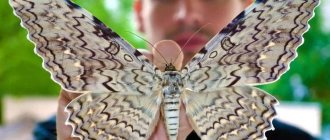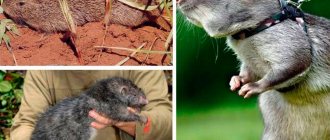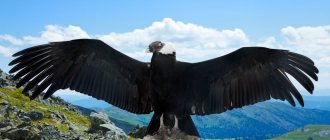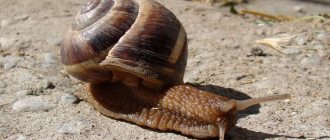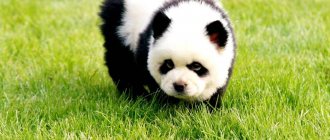Panda: general characteristics
These animals belong to the class of mammals and are part of the bear family. Theoretically, they belong to the order of carnivores, but pandas' diet consists mainly of plant foods, although in rare cases they can eat eggs, fish and small animals.
Pandas are one of the most unusual inhabitants of the planet
Pandas are large in size, have a massive body and thick, strong limbs. The height of adult individuals varies from 1.2 to 1.6 m, and weight can reach up to 160 kg. In general, pandas resemble ordinary bears in their appearance with one small difference: these creatures have a tail, 10-15 cm long.
Pandas' hind legs are equipped with sharp claws, and on the soles and near the toes of each paw there are flexible pads, thanks to which the animals hold slippery bamboo shoots. In addition, on the front paws of bears there is a bone process in the form of a deformed finger, which helps them break rough bamboo stems.
Pandas' fur is thick and dense, and serves them as excellent protection from the winter cold. But the main feature of these creatures is their unique color. The black and white coloring of bamboo bears makes them very attractive and gives the impression that they are dressed in fancy dress. And the black spots around the eyes give pandas a touching and slightly sad expression.
Basically, these animals move on all four limbs, but they can also take a vertical position, reaching the upper leaves and stems. Pandas' gait is slow and clumsy; they are not capable of moving quickly, as they do not have strength and endurance. Black and white bears have good vision, but they rely more on their hearing and superbly developed sense of smell. They are excellent tree climbers and can swim, although they do not like water too much.
The lifespan of pandas in the wild is 12-15 years. In captivity, this figure increases to 25-35 years.
Elena
Ask a Question
Question to the expert
Is it true that in China there is a death penalty for killing a panda?
Until 1997, the PRC actually had a law according to which a person who killed a panda was sentenced to death. But now killing a bamboo bear is punishable by 10 years in prison. And in the presence of aggravating circumstances, the offender faces life imprisonment.
Diet of a giant panda - What do pandas eat?
99% of a giant panda's daily diet is bamboo
Pandas eat the roots, shoots and leaves of bamboo. Bamboo makes up 99% of their daily diet. In addition to bamboo, they feed on some types of fruits.
Giant pandas in captivity are fed special bread made from rice and corn flour, soybean powder and eggs. Wild pandas also eat grasses, insects, mice and even lambs found in surrounding villages.
Read more about what pandas eat.
Where do pandas live?
The homeland and original habitat of all pandas is China. These animals are found exclusively in China, and even then in certain regions. Giant pandas are found in the central Chinese province of Sichuan, with a small population remaining in the highlands of Tibet.
You can only meet a panda in the wild in the mountains of China.
There are no more than 2 thousand bamboo bears worldwide, and more than half of them are kept in parks and national reserves. The few individuals remaining in the wild live where bamboo grows, inhabit mixed, deciduous and coniferous forests, and prefer to hide from human eyes in the mountain hills.
See a panda in China
Chengdu is the best place in China to watch giant pandas
Giant pandas in China live in the west and southwest of the country. The city of Chengdu is, without exaggeration, the best place to meet these cute animals. Here you can visit a giant panda and get acquainted with the habits of the animal, which has become one of the symbols of the Celestial Empire.
Giant pandas are dearly loved not only by the residents of China, but also by many foreigners - children and adults. The best places in China to see pandas are located around the city of Chengdu, which is called the “homeland of the giant panda” . In addition, the panda can be seen in zoos in cities such as Beijing, Shanghai, Chongqing, Guilin and Hong Kong.
If you are curious to watch the panda in its natural habitat, come to Sichuan Province! More information on how to visit the giant panda is available on the China Panda Tours page.
And you can get even closer to the panda by taking part in a volunteer program at the Dujiangyan China Conservation and Research Center for the Giant Panda (CCRCGP) near Chengdu. Here you can take care of and even feed a giant panda .
In addition to the giant panda, you can watch and learn a lot about red pandas in the Chengdu Nature Reserve.
Types of pandas
Until the mid-20th century, the great Chinese panda was considered the only representative of its genus. But in 1960, scientists discovered a population of bears, which, after much study, were classified as members of the panda family. And at the moment, in the classification of these animals, two subspecies are distinguished:
- Ailuropoda melanoleuca (giant panda). These are typical pandas with black and white fur, and they are what the whole world knows as bamboo bears.
- Ailuropoda melanoleuca qinlingensis (big brown or brown panda). And these are their closest relatives, who received the status of a separate variety in 2005.
In the Himalayan mountains, some Chinese provinces, Nepal and Bhutan, there is an animal called the red fire panda. These unique creatures are small in size, weighing only 3 to 6 kg, have a bright red or brown color, and look like raccoons.
This unusual and cute animal is called the little fire panda
But, despite the name, these furry babies have nothing in common with giant pandas, except that they are united by a passion for eating bamboo. Although zoologists have determined that both animal species had a common ancestor, their subsequent evolution followed different paths, so that the giant panda and the red panda belong to separate genera.
Big brown panda
The natural habitat of these bears is limited to the Qinling mountain system, located in the southwestern Chinese provinces of Henan and Shaanxi. The brown panda is also called the Qinling panda, in honor of the mountains that have provided them with reliable shelter for many centuries. For their residence, these creatures chose inaccessible mountains, located at an altitude of 1300 to 3000 km above sea level, and lead such a hidden lifestyle that scientists did not even believe in their existence at first.
Brown pandas are still practically unstudied; zoologists know little about their reproduction and habits. After all, over the past three decades, scientists have been lucky enough to see them in the wild no more than five times. In 1989, with the help of local residents, a young female brown panda, named Deng-Deng, was captured and placed in a Chinese zoo. When she reached maturity, she was crossed with a regular black and white male. Dan-Dan became pregnant and gave birth to three non-viable cubs, after which all attempts at further captive breeding failed.
Dan-Den herself lived a long life; at the time of her death she was 29 years old. Thanks to the study and observation of this truly priceless specimen, zoologists have compiled an approximate description of the brown panda species.
These animals differ from their black and white relatives in their smaller size and color. The brown panda has a light brown or beige background, and this is another mystery that scientists have yet to solve. After all, they were never able to determine what caused such an unusual shade for pandas. So far, the main version is that the color of their fur is the result of a genetic mutation, which sounds quite plausible, because staff at the reserves have recorded cases of black pandas giving birth to babies with a brown color.
And yet, the genome of brown pandas has not been fully deciphered. But experts who have studied their DNA have concluded that brown and black-and-white pandas are not closely related genetically, so interbreeding between the two species is unlikely to be possible.
But otherwise, these creatures can be called typical pandas. They are just as slow and lazy, spend most of their time eating bamboo, and have little interest in the opposite sex and mating games. And it is the last two points that cause the greatest concern among scientists. After all, according to rough estimates, there are no more than 300 representatives of brown pandas in the Qinling Mountains, so their population is even smaller than their black and white fellow tribesmen.
Zoologists do not even risk approaching animals, so as not to disturb shy bears, and conduct covert surveillance of them. But, since there are no predators in the habitats of brown pandas, and people do not hunt them, there is always hope for the revival of these unique creatures.
Poll: did you know about the existence of brown pandas?
Yes, I even saw a whole program dedicated to these animals.
20%
Yes, I accidentally came across an article about them on the Internet.
40%
Yes, I heard about brown pandas, but it seemed to me that this was an invention of scammers.
5%
No, I had no idea about their existence.
35%
Voted: 20
Social structure and reproduction
Photo: Great white panda
Pandas are known to be very caring, patient and loving parents. Animals tend to form a pair only for the period of marital relations. This period is seasonal and begins with the first days of spring. Each mature female can bear offspring twice a year and give birth to 1-2 cubs. The period when mating can lead to fertilization lasts only three to four days.
Interesting fact: After mating, embryo development does not begin immediately. From the moment of mating to the start of embryo development, it can take from one to 3-4 months! In this way, nature protects the cubs by selecting more favorable climatic conditions for their birth.
The gestation period lasts about five months. Babies are born completely helpless - they cannot see anything, they have practically no hair. Bear cubs are born very small. The weight of one baby barely reaches 150 grams. The cubs are completely unadapted to life in the environment and are entirely dependent on their mother. The mother bear, no matter what she does, remains close to her cub all the time. Newborns feed heavily in the first months of life. The number of feedings reaches 15 times a day. After just two months, the cubs weigh four kilograms, and by six months they gain as much as ten.
At about a month, the cubs begin to see and gradually become covered with fur. When they reach three months of age, they begin to walk. Babies begin to move independently and explore space only at one year of age. They feed on mother's milk for the same amount of time. They need about another 6-8 months to adapt to the environment. After this, they begin an isolated lifestyle.
If a female gives birth to two cubs, most often she chooses the stronger and more viable one and begins to care for and feed him. The fate of the weakest is starvation. When breeding in captivity, people most often separate the rejected cub and periodically swap it with a stronger cub until it becomes independent.
The period of puberty in black and white bears occurs when they reach 5-7 years. The average lifespan of bamboo bears in natural conditions is 15-17 years. In captivity they can live almost twice as long.
What do pandas eat?
It’s not for nothing that pandas are nicknamed bamboo bears, because their main diet consists of this tropical evergreen plant. In the natural habitat of the black-and-white creatures, there are about 25 varieties of bamboo, each of which is readily eaten by pandas.
Panda eats his favorite bamboo
Animals consume all parts of the plant: stems, leaves and even roots. And since bamboo can hardly be called high-calorie and nutritious, pandas have to spend 10-12 hours a day eating, methodically chewing juicy bamboo shoots. To satiate an adult bear, at least 25-30 kg of green food is required every day.
The stomach and walls of the panda's esophagus are covered inside with a thick layer of mucus, which helps to poison the harsh bamboo and protects the digestive system from sharp chips and fragments.
But pandas aren't limited to an exclusively bamboo diet. Yes, these plants are their main food, and also serve as a source of water, because animals obtain the necessary liquid from succulent stems and leaves. And yet, bears supplement their menu with other components, including those of animal origin.
The diet of pandas includes:
- Fruits;
- Ferns;
- Leaves of rhododendron, linden, ash bushes;
- Iris and saffron bulbs;
- Tree mushrooms;
- Worms, insects and their larvae;
- Bird eggs;
- Small rodents;
- Birds;
- Fish.
In very rare cases, pandas can eat carrion, but this happens if the natural reserves of bamboo in their territory have decreased, as a result of which they have to starve. And in zoos and nature reserves, these bears are fed with sweet fruits, fresh vegetables, cookies and special mixtures.
The panda was treated to a juicy carrot
Description
In general, giant pandas have a round head, a stocky body and a short tail. The height at the shoulders is 65-70 cm. These animals are well known for their characteristic black and white markings. The limbs, eyes, ears and shoulders are black, while the rest is white. In some regions, the color black actually has a dark red tint. The dark markings around the eyes may be the reason for the popularity of these animals, giving them a naive, juvenile appearance. Enlarged shoulders and neck area along with reduced hindquarters create an ambling gait. The baculum (bone that forms in the connective tissue of the penis) is present in many other mammals. However, in other bears they are straight and pointing forward, while in pandas they are S-shaped and pointing backward.
Giant pandas have several skull bone joints. They have a large sagittal crest that is made wider and deeper by their powerful jaws. The molars and small molars are wider and flatter than those of other bears, which is why pandas have developed the ability to crush tough bamboo. A notable feature of these animals is the extra opposable finger on the hand, known as the “panda thumb.” This has caused much confusion in the past when classifying these bears. In fact, it is not a thumb, but a skin protrusion.
Lifestyle and behavioral characteristics
These creatures prefer to lead a secretive, solitary lifestyle. The activity of pandas does not depend on the time of day; they go in search of food when they get hungry. But, since pandas nominally belong to the class of predators, in most cases they go out to feed at dusk, and during the day they rest in bamboo thickets or on a wide tree trunk.
By the way, the word “activity” itself is unlikely to be appropriate in the case of bamboo bears. After all, these animals are so lazy and slow that they can even fall asleep during a meal. True, there is a reasonable justification for their pathological laziness: bamboo stems contain few nutrients, and the pandas’ body has thus adapted to spend energy sparingly and not waste precious calories on unnecessary movements.
Lifestyle of pandas
Bamboo bears are not conflict animals at all; they do not show aggression or malice towards each other. And at the same time, pandas do not strive for friendly relations and spending time together with their relatives. True, in zoos and nature reserves a group of pandas live peacefully in spacious enclosures, they eat and play together.
Panda's peaceful sleep
But in the wild, each bear has its own personal area with a bamboo plantation and shelters in the form of natural caves or rocky depressions. Interestingly, pandas do not mark the boundaries of their own property with urine and feces, but simply leave deep scratches on the trees. They don’t welcome strangers on their territory, but they won’t start a fight with an uninvited guest. Although females are more aggressive than males and violently chase away black and white neighbors who wander into their areas, their behavior is probably due to fierce competition for food for themselves and their cubs.
Pandas do not have the habit of building shelters for themselves; they rest among dense vegetation, on the trunk of the first tree they come across, or even just on the ground. But during rain, bears take refuge in cave grottoes and rock crevices, since they really do not like dampness and wet weather.
Pandas do not hibernate in winter, but with the onset of cold weather they become more passive than usual and spend more time sleeping than in the warm season. And in winter, animals have to migrate to areas where weather conditions are not so harsh. In December, they leave the snow-covered hills and move to the forests and plains for the winter, where the air temperature is a couple of degrees higher.
Character and habits
Calm, friendly and peace-loving, this is how these large and very charming bears can be described. And, despite their caution, pandas are very simple-minded and naive, and it is these qualities that have brought them to the brink of extinction. After all, the black and white creatures were trusting of people, allowed them to come close, and showed curiosity, not fear, towards them. Therefore, ruthless hunters easily and simply obtained such prey as the skin of a bamboo bear.
After a hearty lunch, you can reflect on life
Recommended by topic
Fox Lynx Leo
Pandas also have such traits as self-esteem and slight arrogance. If other bears frighten with their strength and power, then pandas behave manneredly and nobly, like real oriental sages. It is especially interesting to observe what poses these animals take while resting. Pandas love to sit with their backs leaning against a tree trunk, reminiscent of a tired wanderer who decided to rest after a long journey. At the same time, bamboo bears can also cross their lower paws, directing their gaze into the distance, and indulging in philosophical thoughts about the transience of time. Or maybe no sublime thoughts arise in the pandas’ heads, they simply enjoy the peace, quiet and soothing sounds of their native forest.
Pandas living in zoos and nature reserves are more active than their counterparts living in the wild. In captivity, these creatures often play, splash in the pool, and arrange playful fights with each other with somersaults and rolling on the ground. Perhaps their behavior is due to the fact that bears do not have to save their energy in search of food, and they can afford fun entertainment.
Pandas are rather quiet and silent animals; they do not know how to roar, grumble and groan, like ordinary bears. The cubs make sounds vaguely reminiscent of the crying and whimpering of a small child. Adult pandas greet each other with strange sounds, similar to the bleating of a baby goat. Bamboo bears show fear and irritation by “humming,” and a wounded or sick panda squeals shrilly.
On what continent do pandas live?
Where does the panda live on what continent? I am interested in many things, and especially, today, in design in its various forms... The panda, unfortunately, lives only in Eurasia. Red pandas used to live in North America, but now this species has become endangered.
Interesting materials:
How to find out what part of speech a word is? How to wrap words in Google Sheets? How does the word Irtysh sound in translation from Khanty? How will the word socks be in the genitive case? How are ambiguous words defined in the dictionary? How to make words closer to each other in Word? How to replace all the same words with others in Word? As always, introductory words? How is the introductory word emphasized? How do you understand what the words natural satellite mean?
Enemies in the wild
In their natural habitat, pandas can feel completely safe. There are no large predators in their neighborhood, so black and white bears can calmly eat their favorite bamboo, without fear of attacks from four-legged hunters.
Pandas don't have to look around for threats
And yet, scientists believe that in the old days pandas had to fight off predatory animals. For example, they could fall prey to a member of the cat family such as the clouded leopard, which is found in the subtropical forests of Sichuan. True, given the fact that the weight of leopards is no more than 20 kg, they could hardly hunt adult pandas, and their prey most likely became immature cubs.
In the mountainous areas of western China and Tibet, another large predator is found - the red (also known as the mountain or Himalayan) wolf. These animals lead a gregarious lifestyle, and could easily attack pandas who did not even have a chance to defend themselves from a hungry pack.
But now both the clouded leopard and the red wolf, along with the panda, are listed in the International Red Book as very rare, endangered animals. And since pandas are constantly monitored by employees of protected areas, these predators do not risk approaching bears, preferring to stay away from human eyes.
Giant Panda in China – Private Tour with China Highlights
Come to Chengdu to visit the giant pandas!
If you are interested in seeing panda cubs or observing wild pandas, come to Chengdu! For your inspiration, we have prepared the following individual tours with a visit to the giant panda reserve:
- Tours to China to visit pandas
- Tours in Chengdu
- Yangtze River Cruise and Giant Pandas
You can choose a ready-made tour or use it as a basis to create your own. To do this, just write to China Highlights consultants, and we will help you turn your ideas into unique, logical routes.
Beautiful legend
The charming black and white bear cub has earned fame and love all over the world. There is an ancient legend in China that explains the panda's coloring.
According to this legend, once upon a time, a family of shepherds settled on the slopes of the mountains. Every day, the shepherds took a flock of sheep to the pasture, where a little panda came to play with them. But one day a leopard attacked the sheep. The sheep ran away, but the little bear cub could not run fast and did not have time to hide. And he could not escape death. But the young shepherdess took a stick and drove the leopard away from the little bear cub, and she herself died from the claws of the terrible beast.
Having learned about this, the pandas began to cry and sprinkled themselves with ashes as a sign of mourning for the brave girl. Wiping away tears, they left black spots on their snow-white skin
Since then, the panda skin has been a mourning for the dead girl.
Characteristics of a panda
The anatomy of pandas is unique, as it contains characteristics of both the bear and raccoon families. The classification of these animals was accompanied by controversy among scientists. After much research, they determined that giant pandas are bears.
Is a panda a raccoon or a bear?
Externally, a panda looks like a bear. Unlike ordinary bears, it has a different paw structure and a tail about 12 cm long. Pandas have a unique color - the main color of the fur is white, with black ears, legs and shoulders, and black spots near the eyes, creating the effect of glasses. All this combined with a cute face makes the panda look like a big teddy bear.
The structure of the panda's paw is “grasping”. This helps animals climb high into trees. They do this for different purposes - in search of food, to survey the surroundings, just to play or relax, lying on the branches.
Panda eats
These animals live in dense bamboo thickets, which serve them as food and shelter. Young bamboo stems and leaves are the main food of pandas. They hold the bamboo stem in their paw using the so-called “sixth finger,” which is opposed to the others. In fact, it is not a finger, it is a growth on one of the bones of the paw. With its help, pandas can hold objects in their paws, successfully climb trees, grab branches and perform other actions that are inaccessible to ordinary bears.
The menu of these animals consists almost 100% of bamboo. Leaves and young shoots are eaten, but not of all types of bamboo, but only 10-15 out of 300 growing in China. A panda can eat 14 hours a day, and during this time eats about 20 kilograms of food.
Relationship between people and animals
These are extremely peaceful animals; they never attack humans. In ancient books, the panda is called a symbol of peace, since it does not kill living creatures. But there are very few of them left in the world, and the reason for this is man. People, in pursuit of profit, exterminated these charming bears for the sake of valuable skins, cut down bamboo forests, thereby depriving not only pandas of food and housing, but also other animals.
Panda on the symbol of the WWT organization
Nowadays people are thinking about this problem. China has introduced the death penalty for killing or harming pandas. The habitats of pandas have been declared protected areas, and zoos around the world preserve and increase the number of these animals.
It’s just a pity that people, for the sake of profit, without thinking, disturb the natural balance, only to then restore it with great difficulty and expense.
Interesting Facts
It turns out that for the first time, when scientists conducted research on a large species of these animals, they could not understand for a long time who the panda was and what kind of animal it was. A little later they came to the conclusion that she was a raccoon, but only of enormous size.
After some time, other experts refuted this opinion, since with the help of a genetic test it was possible to establish that this species of animal is more related to bears. As for red pandas, many scientists generally recorded them as a marten-like species, which consists of the mustelidae family, as well as raccoons and skunks.
Top Articles: Artroglycan for Cat Joint Health
Although, according to most researchers, these two subspecies belong to different classes, they still have a certain similarity with each other. For example, both pandas have a sixth "pseudo-toe" located on their front paws. It is significantly larger than the other five.
Lifestyle and habitat
The red panda, like many animals, goes hunting at night. Then it feeds on bamboo, larvae, and plant roots. At dusk, the eyes of the “fire fox” see well. This allows her to easily move along branches and find shelter from predators - bears and martens.
The nocturnal lifestyle is a characteristic feature of the Ailurs. During the day the animal sleeps. In the warm season, the panda likes to perch on branches. When it’s cold, it looks for warmer shelter: in a hollow tree. It builds a nest for itself from branches and leaves.
The character of the red panda is not aggressive. Thanks to this, she finds a common language with the inhabitants of the forest. They live in pairs or families. The male does not take part in raising the cubs, so the main burden of providing food for the “babies” lies on the shoulders of the mother.
Small pandas cannot tolerate temperature changes and are difficult to cope with changing climatic conditions. Because of this, their species is distributed only in the following regions:
- Northern Myanmar, Burma;
- East Nepal and India;
- Butane;
- Southern provinces of China (Sichuan, Yunnan).
The favorite terrain where the red panda lives is the mountainous heights of the Himalayas, at an altitude of 2000-4000 meters above sea level. The “Fire Fox” lives in the same place as the giant panda. Animals require an abundance of vegetation for good nutrition and shelter. Tall coniferous and deciduous trees protect bamboo from frost.
Rhododendrons also play a significant role here. Interspersed with bamboo thickets, they provide high soil moisture. Coniferous species are represented mainly by pine or fir. Deciduous - chestnut, oak, maple.
The climate in the mountains is moderate. The average annual precipitation does not exceed 350 mm. The temperature ranges from 10 to 25℃. It is cloudy here most of the time. Therefore, there is an abundant growth of lichens and mosses. Since there are so many plants here and the roots are actually intertwined, this results in maximum soil moisture.
Population density of the red panda: 1 animal per 2.4 sq. km. Due to poaching, the number of animals is declining. Therefore, the living density of a fire cat can reach 11 sq. km.



